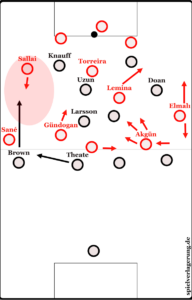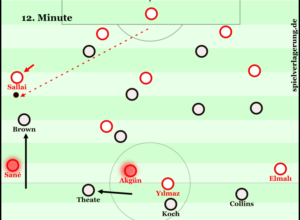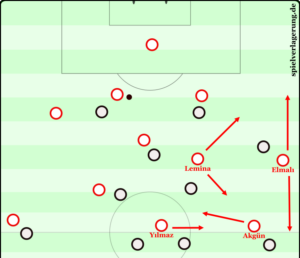Frankfurt’s pressing adjustments secure victory over Galatasaray – MH
Eintracht Frankfurt won their opening Champions League matchday with a 5-1 victory over Galatasaray Istanbul. After about ten minutes, Frankfurt were trailing 0-1, but thanks in part to adjusted pressing, they were able to turn the game around. What follows is an aspect analysis of Frankfurt’s attacking press against the Istanbul side’s build-up play.
Frankfurt started, as usual, in a nominal 4-2-3-1. Ahead of the two midfielders Chaibi and Larsson, Uzun operated in the No. 10 role. On the left flank, winger Knauff played in front of left-back Brown. When dropping into a deeper defensive press, this structure shifted into a 4-4-2, with Burkardt and either Uzun or Knauff forming the first pressing line. In the transition to the attacking press, they shifted man-oriented as usual.
Galatasaray also began in a nominal 4-2-3-1. In possession, their structure changed depending on the depth of their build-up, forming something like a 3-2-5 or 4-2-4 through the positioning of the full-backs. Width on the right side was provided by winger Sané, and on the left by full-back Elmalı. Left winger Akgün frequently moved inside, acting as a kind of “free player.” Meanwhile, right-back Sallai tucked in slightly in higher possession phases to help form a back three in the build-up.
 Galatasaray’s Build-Up Play
Galatasaray’s Build-Up Play
Galatasaray’s build-up was characterized by frequent rotations. Their basic reference point was the previously described 3-2-5. From this shape, they consistently sought positional interchanges in order to manipulate the opponent’s man-marking in the pressing phase. On the left side, Elmalı, who provided width, was able to vary his height. In deeper build-up phases, he often dropped further back, while he also regularly positioned himself on the last line. Winger Akgün was tasked with creating central overloads and repeatedly moved inside, at times even drifting over to the right side. In response to the full-back pushing high, the left holding midfielder, Lemina, rotated into the left-back position. Striker Yılmaz, in turn, shifted into the left half-space when the full-back stayed deeper and the winger dropped centrally.
The purpose of these rotations was to manipulate man-marking and tie down specific Frankfurt players. Because winger Akgün frequently dropped into central areas, the two centre-backs, Koch and Theate, were occupied. Akgün positioned himself in front of striker Yılmaz in order to stretch the last line and create 1v1 opportunities. This produced a variety of different build-up structures, which required Frankfurt to constantly reorient themselves. For example, if Elmalı pushed high, he had to be tracked by Collins, and Galatasaray’s four attacking players tied down Frankfurt’s entire back line. This significantly complicated Frankfurt’s transition into man-marking, as the positioning of the forwards forced centre-back Theate to cover long distances during handovers.
Frankfurt’s Pressing
Frankfurt’s plan, as in previous matches, was to shift into man-marking from a +1 overload through the handover of the opponents’ centre-backs and full-backs. The advantage of this approach is that spaces on and behind the last line can initially be secured, while the risk of a long ball leading to a 1v1 situation is minimized by having an additional covering player.
At the same time, after steering the opponent’s attack, the transition into man-marking could be executed to apply maximum pressure on the ball carrier. Depending on the opponent’s structure and build-up sequences, Frankfurt adapted their pressing schemes. For instance, they could vary the distance to their opponents during the pressing jump: larger distances allowed for greater security in coverage, while smaller distances created more immediate pressure.
Galatasaray tried to make these handover moments as difficult as possible for Frankfurt by forcing the distances at the moment of transition into man-marking to become as large as possible. The aforementioned rotations, for example, forced Theate into long runs to pick up winger Sané, so that Brown could then jump out to the still unmarked and deeper-positioned right-back of Galatasaray.

Because of Galatasaray’s attackers’ positioning, Theate and Brown are forced into long pressing runs. On top of that, Theate finds himself caught between two opponents due to the rotations.
Galatasaray also tried to open up the center through certain rotations, aiming to draw Frankfurt’s midfielders out of central areas. Frankfurt tracked man-to-man with Larsson on half-space player Gündogan and Uzun on the deeper right-sided pivot Torreira. Depending on the side of build-up, Chaibi was prepared to jump onto the more advanced pivot, Lemina. Because Lemina often rotated into the full-back position, Doan frequently picked him up, leaving Chaibi or Collins (depending on the movements of Akgün and Elmalı) unexpectedly without a direct opponent. At the same time, Gündogan and Torreira sometimes rotated in opposite directions, which created difficulties for Frankfurt in terms of handovers in central areas.
Because Frankfurt found it increasingly difficult to press Galatasaray’s build-up through their usual handover approach, from around the 15th minute they opted for tighter marking distances to transition more quickly into full man-marking. Brown pushed up directly, Theate went straight onto Sané, while Collins and Koch marked the two remaining forwards. This created a 3v3 situation on the last line. Although this increased the pressure on Galatasaray and led to more turnovers in their build-up, it also raised the risk against long balls due to isolated 1v1s. Time and again, Galatasaray managed to exploit this by sending strong dribblers like Sané into such spacious 1v1 situations. Even so, the tighter marking distances resulted in a much more balanced game with more frequent ball recoveries.
In the 30th minute, Frankfurt used a longer stoppage to make more significant pressing adjustments. Winger Knauff no longer pressed Galatasaray’s right centre-back but instead oriented himself toward full-back Sallai. This allowed Brown to stay on Sané, and Theate no longer had to make long runs out wide to cover him. At the same time, it was no longer problematic if all four defenders were tied up, as they no longer needed to jump out of the back line. The free centre-back was now primarily pressed by Uzun, who used his cover shadow to block passing lanes into pivot Torreira. Galatasaray’s build-up on the right side could then be pressed man-to-man through ball-oriented shifting. To this end, Chaibi stepped onto Uzun’s original opponent, Torreira, and the far-side Doan also moved into the ball-near center.

Frankfurt’s pressing adjustments: With no need to shift across the last line anymore, Frankfurt gains situationally much better access with less risk. These changes spark the turnaround in the match.
The pressing adjustments led to significantly better situational access and, at the same time, to much stronger defensive security. Frankfurt were able to use the resulting ball recoveries to establish longer possession phases, which gave them a more dominant style of play. One such spell of possession resulted in the 2-1 lead shortly before halftime. Immediately afterwards, a ball recovery from the adjusted attacking press led to a free kick, which in turn produced the 3-1 at the break.
Conclusion
In the opening 30 minutes, Galatasaray were able to cause Frankfurt problems, thanks in part to a very elusive build-up play that challenged Frankfurt’s typical pressing approach with its reliance on handover moments. Frankfurt’s adjustments, however, proved perfectly suited to applying pressure more easily while also improving defensive cover. The short interruption of play came at just the right time for Toppmöller and his coaching staff to implement the necessary measures. As a result, the pressing changes were decisive for Frankfurt’s eventual 5-1 victory and a successful start to their Champions League campaign.
Author: MH is a football aficionado at heart. His apartment resembles a football library, with shelves filled with books on the great tacticians from Rinus Michels to Pep Guardiola. Of course, the book from Spielverlagerung.de is not missing. For MH, football is not just a game, it’s a way of life. He can be found on X under Mh_sv5 and LinkedIn.




1 Kommentar Alle anzeigen
Aydan Tanner September 30, 2025 um 9:19 am
This cleared up a lot of uncertainty — I feel more confident now.